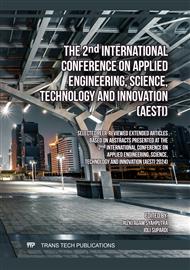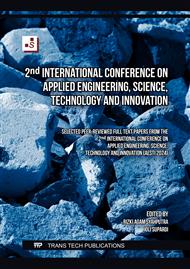p.3
p.11
p.23
p.33
p.41
p.51
p.59
p.75
Study of the Compressive Strength of Geopolymer Concrete Using Rice Husk Ash and Seashells in Rigid Pavements
Abstract:
Rigid pavement is a type of pavement that uses cement as the main binding material and has a high level of stiffness. The prolonged use of cement has increasingly negative impacts on the environment. Using geopolymer as a substitute for cement can be an eco-friendly alternative solution. Geopolymer is an environmentally friendly material that can be developed as an alternative to cement concrete in the future. The purpose of this study is to determine the compressive strength of geopolymer concrete using rice husk ash and shell as fine aggregates in rigid pavement. The research method used is experimental. The method used for mix design calculation is AASHTO 1993, by making 8 test specimens. Each test specimen uses 4 aggregate and binder ratios, which are 75:25, 70:30, 65:35, and 75:25, each with 2 alkaline activator ratios, which are 3:1 and 5:2. The compressive strength testing of the specimens was conducted at 28 days. The concrete quality used, K225, is equivalent to 18.68 MPa. The compressive strength testing of geopolymer concrete achieved optimum compressive strength at a variation of 65:35 aggregate, 3:1 alkaline, 5% rice husk ash, and 5% shell, which was 18.9667 MPa. At the variation of 75:25 aggregate, 3:1 alkaline, 5% shell, the highest value was 21.4013 MPa. Based on the type of concrete according to its compressive strength, geopolymer concrete with fly ash, rice husk ash, and shell is classified as normal concrete because its compressive strength exceeds 15 MPa and can be a substitute for cement with relatively low strength.
Info:
Periodical:
Pages:
33-40
Citation:
Online since:
June 2025
Authors:
Keywords:
Price:
Сopyright:
© 2025 Trans Tech Publications Ltd. All Rights Reserved
Share:
Citation:



